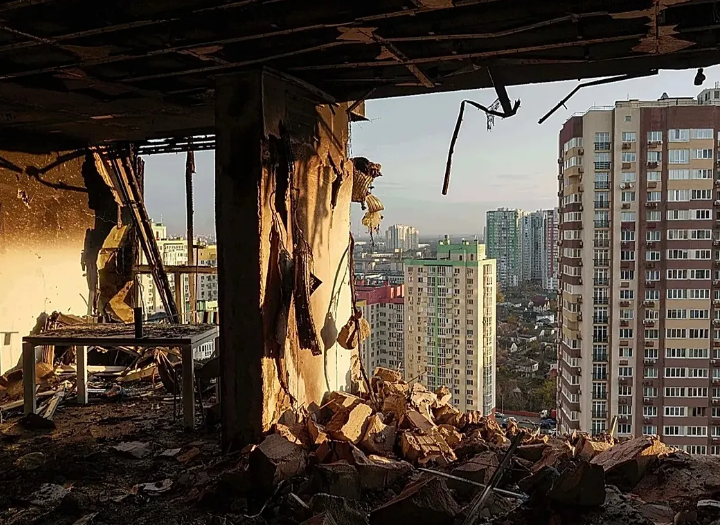
From China to Serbia by plane, then to Sarajevo by bus.
This is how two Chinese citizens, young men in their early twenties, describe their migrant journey.
“I paid for the bus ticket and that’s how I arrived,” Yong told RFE/RL about how he got from Serbia to Sarajevo.
Chinese citizens do not require a visa for a stay of up to 30 days in Serbia, while the visa-free regime for Bosnia and Herzegovina (BiH) permits a stay of up to 90 days without a visa.
Yong and Chen are in the Blažuj migrant camp, about ten kilometers from Sarajevo. These are not their real names as they did not want to identify themselves.
They are among several hundred Chinese migrants who have appeared since the beginning of the year on the Western Balkan route, which opened in 2015 when hundreds of thousands of refugees from the Middle East and North Africa fled to Europe due to wars.
According to data from Frontex, the European Border and Coast Guard Agency, 482 Chinese citizens were detected illegally crossing borders on this route from the beginning of the year until September.
And in the last three months alone, four groups with over 50 Chinese citizens were discovered attempting to cross the border illegally on the Western Balkan route. In one of those attempts, at the beginning of October, one Chinese citizen died when a boat capsized on the Danube.
Yong and Chen, with whom RFE/RL spoke in front of the Blažuj camp, are reluctant to talk, and thus do not want to discuss the reasons why they left China.
Twenty-one-year-old Yong said he is considering the possibility of going to one of the European Union countries, but that he has not attempted it and does not know how he would do it.
“I want to stay here and find a job, earn some money. Maybe I will look for a job in a store, I could work as a salesperson,” says Yong. He came from Henan province and worked as a food delivery person in his country.
In Blažuj, he met Chen, who arrived from Jiangsu province. Chen worked as a kitchen assistant in China.
They do not have money to pay for accommodation and claim that their belongings disappeared and they lost their passports upon arrival in Bosnia, refusing to speak about the details. When asked if they sought help from the Chinese embassy regarding their passports, they say they do not intend to and expect help from the International Organization for Migration (IOM). The two also say they met several other people from China at the camp.
According to official data, five Chinese citizens were staying at the Blažuj reception center at the end of October. This is an open-type camp that users can leave as they wish. Two Chinese citizens were staying in the other camp, Ušivak, near Sarajevo.
The Commissariat for Refugees and Migration of Serbia did not respond to RFE/RL’s inquiry about whether there were Chinese citizens in reception camps and asylum centers in 2024 and 2025. Neither did the Chinese embassies in Belgrade and Sarajevo respond to RFE/RL’s inquiry about the appearance of Chinese citizens on the Balkan migration route.
How do Chinese migrants reach the Balkans?
Only one airplane flight brings Chinese citizens close to the borders of Western countries and the European Union (EU). Then, from Serbia and Bosnia and Herzegovina, for which they do not require visas, they attempt to go further West.
Radoš Đurović from the non-governmental Belgrade Center for Protection and Assistance to Asylum Seekers explains the presence of Chinese migrants on the Western Balkan route this way. Serbia opened its doors to Chinese citizens with its visa-free regime, a country with which it has been intensifying political, economic, and military cooperation over the last decade.
One of the EU countries they attempt to enter from Serbia and BiH is Croatia. 454 Chinese citizens expressed their intention for international protection in that country in 2024, and 377 in the first nine months of 2025.
“All of them arrived from Bosnia and Herzegovina and Serbia, abusing the visa-free regime in those countries,” the Croatian Ministry of Internal Affairs told RFE/RL.
The Ministry of Internal Affairs of Serbia did not respond to RFE/RL’s inquiry about how many Chinese citizens were recorded illegally crossing the border during 2025.
Meanwhile, according to data from the Border Police of BiH, the smuggling of more than 140 foreign citizens, mainly in attempts to cross the border towards Croatia, has been prevented since July alone. Most of them were citizens of China, Egypt, Morocco, Bangladesh, and Pakistan.
Over a million Chinese sought asylum abroad between 2012 and 2024, according to data from the United Nations High Commissioner for Refugees (UNHCR). Although the United States is their primary target, it is evident that a number of Chinese migrants want to reach Europe.
Laura Harth from the international human rights organization Safeguard Defenders told RFE/RL that the Balkan route, similar to illegal immigration routes to the US, could be used as a test path. “For those who want to reach Europe via illegal migration routes, especially with the dangerous involvement of human trafficking networks,” she added.
Precisely because of the exploitation of the Western Balkan route for illegal migration, the United Kingdom, in mid-October, imposed sanctions on Balkan criminal groups for selling false passports used in human trafficking, as well as on several individuals involved in financing illegal migration. At the same time, British border security officers were deployed in the Balkans for the first time with the aim of breaking up networks smuggling migrants to the UK. The British government stated in a press release that it had disrupted a key route for illegal migration to the UK “by sanctioning gangs exploiting the Western Balkan route and financiers supplying equipment for small boats.”
Frontex, however, says that a sharp drop in illegal crossings of 78 percent was recorded on the Western Balkan route in 2024 after strong efforts by the region’s countries to stop the flow. “This downward trend continues this year, with a 47 percent drop in the detection of illegal border crossings in the first nine months compared to the same period last year,” Frontex added in its response to RFE/RL.
Frontex completed its presence in all Western Balkan countries with the deployment of its personnel on the borders of BiH at the end of October, with the aim of strengthening border control and fighting illegal migration. The European Commissioner for Home Affairs and Migration, Magnus Bruner, said at the time that this contributes to a reduction in illegal border crossings of more than 90 percent over the past three years.
What do the numbers say in Serbia and BiH?
Nikola Kovačević from the non-governmental Center for Research and Development of Society (IDEAS) says that Chinese citizens are not uncommon either as tourists in Serbia or as people coming to migrate further towards Europe.
“My indicator is the number of Chinese people seeking asylum in Serbia, which has grown in the last two years,” he says when asked about Chinese migrants on the Balkan route. “That’s a few people, but before there were none at all,” he stated.
Kovačević says that according to data from the Ministry of Internal Affairs of Serbia, there were three asylum requests from Chinese citizens in the first nine months of 2025, and one in the previous year. According to these data, he adds, the intention to seek asylum was expressed by three Chinese citizens in 2022, eight in 2023, three in 2024, and five until September 2025.
The Migration Profile of Serbia for 2024 also states that a measure of removal from the territory of Serbia was imposed on 27 Chinese citizens in 2024. In that official document, illegal border crossings are cited as the most common reasons for the removal of foreigners, at even 72.8 percent.
Radoš Đurović, whose organization helps asylum seekers, says they do not often encounter Chinese citizens. “That means a few cases during the year, and the Center works with over 2,500 people annually, which does not mean those people don’t exist. They don’t have to come into contact with us if the smuggling is successful,” he explained. “It is extremely rare for people from China to be found in reception centers,” he added.
According to data from the Ministry of Security of BiH, the number of Chinese citizens detected in illegal border crossings has been rising for the last two years. From two in 2023, that number rose to 151 in 2024. Few of them express the intention for asylum in BiH; thus, during 2024, out of 21,489 migrants who expressed the intention for asylum, there were three Chinese citizens.
Criminal groups also come with migrants
“What we have noticed lately is that criminal groups also come with migrants,” Samir Avdibegović from the association Vaša Prava, which provides legal aid to migrants, told RFE/RL.
He recalled the case of Yong Zhang (42), whom the Court of BiH sentenced to ten months in prison in a first-instance verdict on October 15 for international pandering (facilitating prostitution). He was convicted of soliciting and encouraging prostitution, mainly of Chinese female citizens in Mostar, Sarajevo, Doboj, and Banja Luka, and performing transport from Serbia to BiH.
In Serbia, according to data from the Ministry of Internal Affairs, two victims of human trafficking with Chinese citizenship were identified in 2024.
The Western Balkan corridor is also mentioned in a Europol statement, the EU police agency, in January when the dismantling of a sophisticated Chinese criminal network was announced. This network was involved in irregular immigration and human trafficking for the purpose of sexual exploitation. In raids in Barcelona, Madrid, and Toledo in Spain, as well as in Zagreb in Croatia, 30 people were arrested, including the leaders of the criminal network. The statement noted that by using the Western Balkan corridor, the smuggling group cooperated with local intermediaries and drivers to irregularly transport victims to the EU.
Why are Chinese people increasingly seeking asylum?
According to UNHCR data, the number of asylum seekers from China has increased 11 times since 2012 when Xi Jinping, considered the most powerful Chinese leader in recent decades, came to power. When he came to power, Jinping was thought to bring reforms to the country; today, critics accuse him of creating a totalitarian state.
The organization Safeguard Defenders states that in 2022 alone, the number of Chinese asylum seekers abroad was the same as during the entire ten-year era of Hu Jintao. Laura Harth, an activist with the organization, tells RFE/RL that in addition to the increasingly repressive environment, especially towards ethnic and religious minorities, other factors should be considered.
“The decline of the domestic economy in China, increasingly lower social mobility, and the near impossibility of seeking legal protection for common problems such as illegal land appropriation, unpaid wages, and corrupt officials,” she stated.
Where do Chinese citizens seek asylum the most?
According to UNHCR data in 2024, Chinese citizens submitted the most asylum requests in the United States, almost 148,000. Then Australia, where there were about 14,000, and Canada, almost 5,000. In Europe, Chinese citizens sought asylum most in the United Kingdom – almost 2,500, then Italy – over 2,000, and Germany – over 1,200.

 Azerbaijan protests to Russia after Kyiv embassy damaged in Russian missile attack
Azerbaijan protests to Russia after Kyiv embassy damaged in Russian missile attack  Japan urges China to scale back response in Taiwan row
Japan urges China to scale back response in Taiwan row  Kallas confirms EU working on new sanctions package against Russia
Kallas confirms EU working on new sanctions package against Russia  Germany agrees new military service plan to boost troop numbers
Germany agrees new military service plan to boost troop numbers  US-sanctioned Chinese company in race to build Montenegro highway
US-sanctioned Chinese company in race to build Montenegro highway  ‘Moscow-Belgrade-Ljubljana axis’: Dr. Verčič unpacks Russia’s ‘subtle’ info war
‘Moscow-Belgrade-Ljubljana axis’: Dr. Verčič unpacks Russia’s ‘subtle’ info war